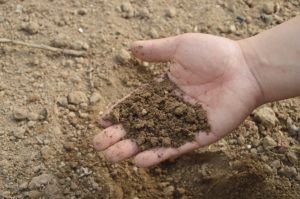Your climate and soil strongly impact your garden. Knowing your soil type and climate and working with them increases your probability of garden success and reduces the work required to gain that success. Here are some things you need to know to have a successful garden in the Fort Bend area.
Your Climate
First, know your climate. The USDA Plant Hardiness Zone is a standard used to help identify the plants that will thrive in your garden. It is based on the average annual minimum temperature divided into 10-degree Fahrenheit zones. Texas zones vary from zone 6 in the northern-most parts of Texas to zone 10 in the southern-most parts. These zones are further divided into 5-degree zones by using an added A (cooler) or B (warmer). Knowing your zone will help you identify the best plants for your climate, such as when you are using the Earth-Kind® Plant Selector. You can determine your USDA Plant Hardiness Zone here.
Your Soil Type

What kind of soil do you have?
Another important piece of information is your soil type. Soil type varies depending on the size and type of particles that it contains. Your type of soil determines how well it holds water and nutrients. Sandy soils are usually made of larger, rocky particles and do not hold water or nutrients well. Soils made of loam are considered ideal because they hold water and nutrients well but allow adequate drainage to avoid problems like root rot. Clay soils hold the most water.
Determining your soil type is easy. All you need is a glass jar, 1 tablespoon of detergent, water and your soil.
- Fill the jar about 1/3 full with your soil.
- Add the detergent and fill the jar almost full with water.
- Shake the jar vigorously and let it sit several hours or overnight.
- If the water is clear, your soil is predominantly sandy soil; if it is a bit murky with small bits suspended in it, it is probably loam; if it is very murky with a visible line of sediment, it is mostly clay.
So, what do you do if your soil is not ideal? Read this Earth-Kind® guide for soil improvement and learn what to do about that.
Your Frost Dates
Once you have determined your climate and soil type, you may be eager to start planting. However, you may want to consider if this is the best time to plant. You would not want to see your plant investment wasted by a freeze or frost. You should consider the average first frost date and the average last frost date for your area to make sure it is safe to plant.
Learn More
Now that you have determined the basics for your garden, learn more at each of these sites.
- Demonstration Gardens: Descriptions of the demonstration gardens at the Fort Bend AgriLife Extension
- This Month in the Garden: This month’s garden happenings
- Question of the Week: Information from recent questions to our Hotline
- Special Topics: Special interests in gardening